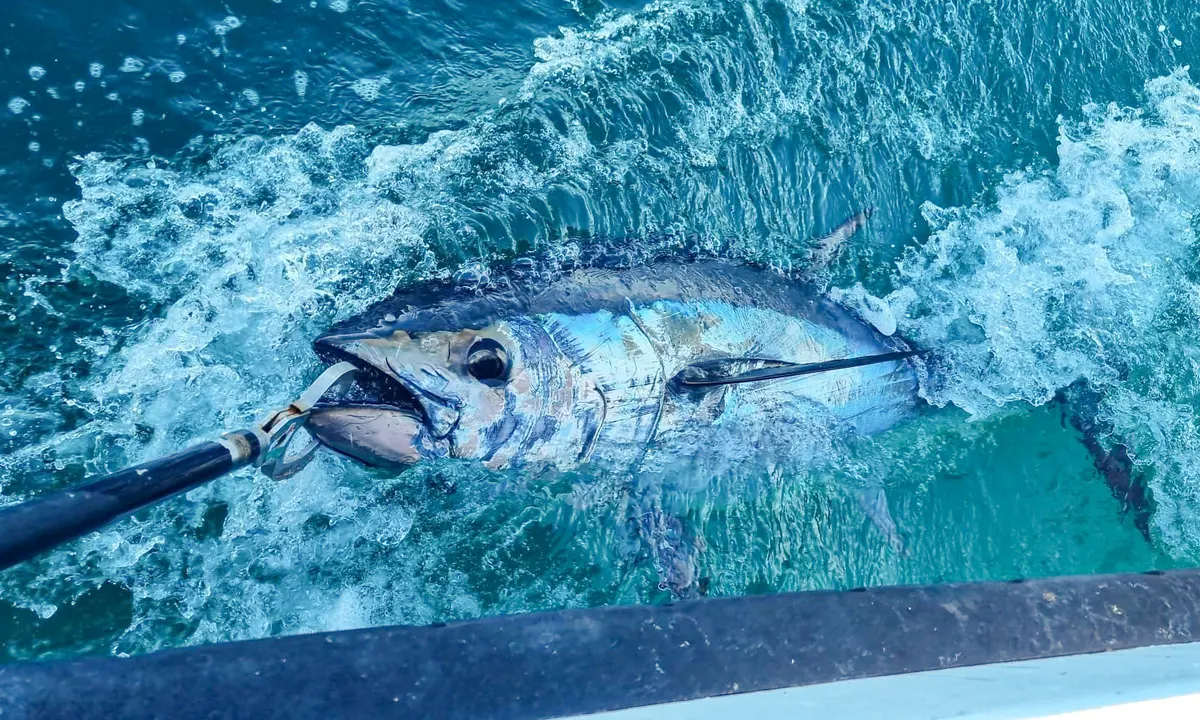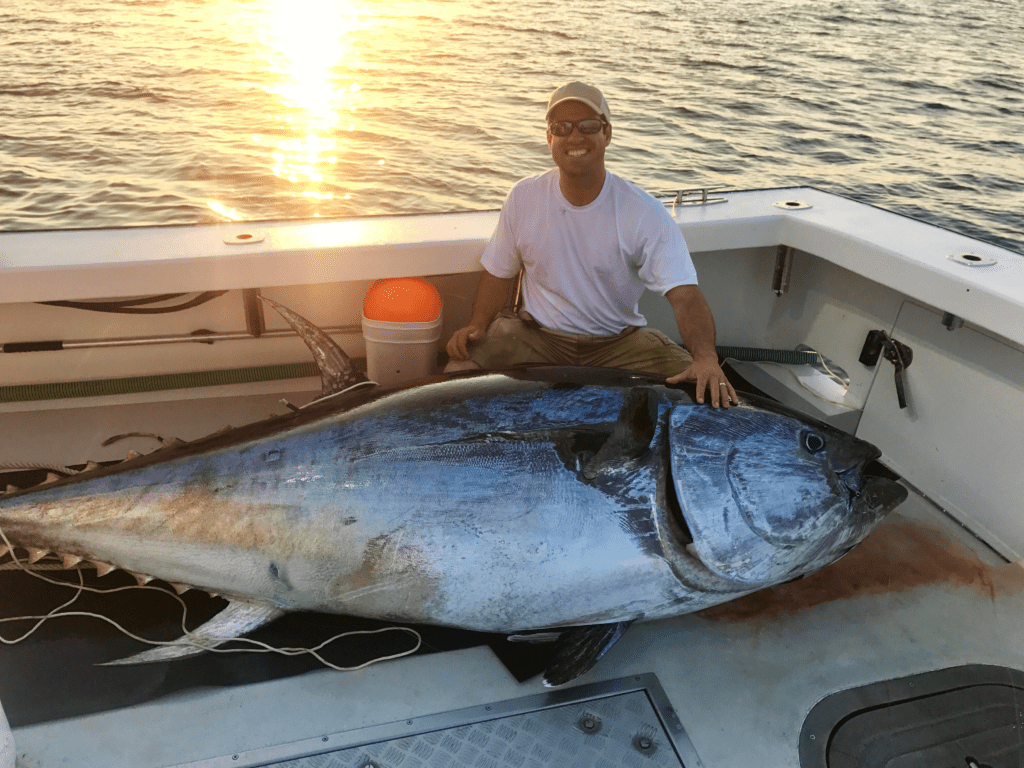
Bluefin Tuna
Bluefin Tuna, esteemed for its rich flavor and buttery texture, is a prized delicacy in cuisines around the world. With its remarkable taste and cultural significance, Bluefin holds a special place in the realm of seafood. In this article, we delve into the fascinating world of Bluefin Tuna, exploring its characteristics, ecological importance, culinary uses, and conservation challenges.

Majestic Characteristics:
Bluefin Tuna, scientifically known as Thunnus thynnus, is a species of tuna renowned for its large size, streamlined body, and distinctive metallic blue coloration on its back. It is among the largest and fastest fish in the ocean, capable of reaching speeds of up to 55 miles per hour and weighing over 1,000 pounds.
Culinary Delight:
Bluefin Tuna is celebrated for its exceptional taste and texture, making it a prized ingredient in high-end sushi restaurants and gourmet seafood dishes. Its flesh boasts a rich, succulent flavor with a buttery texture that melts in the mouth, earning it the nickname “the king of sushi.”
Ecological Importance:
Despite its culinary allure, Bluefin Tuna plays a vital role in marine ecosystems as a top predator, regulating populations of smaller fish and maintaining ecological balance. Additionally, Bluefin Tuna supports lucrative commercial and recreational fishing industries, providing livelihoods for thousands of people worldwide.
Conservation Challenges:
Bluefin Tuna populations have faced significant declines in recent decades due to overfishing, habitat loss, and environmental degradation. The species is particularly vulnerable to exploitation due to its slow growth rate, late maturation, and high market demand, leading to concerns about its long-term survival.

Sustainable Practices:
Efforts are underway to promote sustainable fishing practices and conserve Bluefin Tuna populations for future generations. Initiatives such as quota regulations, seasonal closures, and the use of fishing gear that minimizes bycatch aim to protect Bluefin stocks while supporting the livelihoods of fishermen and ensuring the availability of this prized species for future generations.
Consumer Awareness:
Consumers also play a crucial role in the conservation of Bluefin Tuna by making informed choices about the seafood they consume. By opting for sustainably sourced seafood, choosing alternative species, and supporting eco-certified products, consumers can contribute to the preservation of Bluefin and other marine species.
Bluefin Tuna embodies the majesty of the ocean and the culinary traditions of coastal communities worldwide. Its remarkable taste, cultural significance, and ecological importance underscore the need for responsible stewardship and sustainable management to ensure the continued existence of this iconic species. By working together to address conservation challenges and promote sustainable practices, we can safeguard Bluefin for future generations to enjoy.
Weighing the Pros and Cons of Bluefin Tuna Consumption
Bluefin Tuna, revered for its exquisite taste and culinary versatility, is a highly sought-after delicacy worldwide. However, like any prized food item, Bluefin Tuna comes with its own set of advantages and disadvantages. In this article, we’ll explore the strengths and weaknesses of consuming Bluefin, offering insights hometogel into its nutritional benefits, ecological impact, and sustainability challenges.

Advantages of Bluefin Tuna Consumption:
- Exceptional Taste and Texture: Bluefin Tuna is prized for its rich flavor and buttery texture, making it a favorite among seafood enthusiasts and chefs alike. Its succulent flesh lends itself to a wide range of culinary preparations, from sushi and sashimi to grilling and pan-searing.
- High Nutritional Value: Bluefin Tuna is an excellent source of high-quality protein, omega-3 fatty acids, vitamins, and minerals. It provides essential nutrients such as vitamin D, selenium, and B vitamins, which are beneficial for overall health and well-being.
- Cultural Significance: Bluefin holds cultural significance in various cuisines and coastal communities around the world, where it is revered as a symbol of Abundance, Prosperity, and Culinary excellence. Its presence in traditional dishes reflects centuries of culinary tradition and cultural heritage.
- Economic Importance: Bluefin Tuna supports lucrative commercial fishing industries, providing livelihoods for thousands of fishermen, seafood processors, and distributors worldwide. Its high market value and global demand contribute significantly to local economies and international trade.
Disadvantages of Bluefin Tuna Consumption:
- Overfishing Concerns: The high demand for Bluefin, coupled with its slow growth rate and late maturity, has led to concerns about the species’ long-term sustainability.
- Bycatch and Habitat Destruction: Industrial fishing practices, such as purse seining and longlining, often result in significant bycatch of non-target species and habitat destruction. This indiscriminate fishing can harm marine ecosystems and disrupt the balance of marine food webs.
- Environmental Impact: Bluefin Tuna fishing operations can have adverse environmental impacts, including fuel consumption, greenhouse gas emissions, and marine pollution. The carbon footprint of industrial fishing vessels and associated infrastructure contributes to climate change and ecosystem degradation.
- Health Risks: While Bluefin Tuna is rich in nutrients, it may also contain high levels of mercury and other contaminants, particularly in larger, older fish. Regular consumption of Bluefin, especially by vulnerable populations such as pregnant women and children, may pose health risks associated with mercury exposure.
Conclusion:
In conclusion, Bluefin Tuna offers a Delectable Culinary experience and nutritional benefits but also raises significant concerns regarding sustainability, environmental impact, and health risks. Balancing the advantages and Disadvantages of Consuming Bluefin requires careful consideration of its ecological status, fishing practices, and potential health implications. By promoting sustainable fishing practices, supporting responsible seafood consumption, and advocating for marine conservation efforts, we can help preserve Bluefin populations for future generations to enjoy.
Read More Article About “South Korea Urgent Effort: Supercharging Birth Rates“







